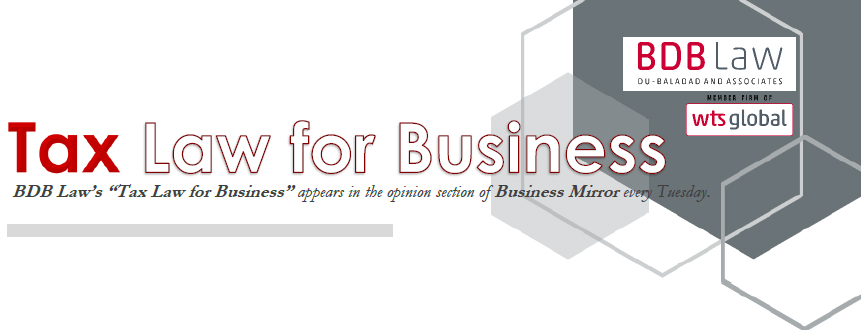
TRAIN 2 Offers Super Incentives
By Atty. Benedicta Du-Baladad
 Contrary to the expectations of many, TRAIN 2 or the Trabaho bill under House Bill 176 that was approved last Wednesday by the House Committee on Ways and Means actually offers not just basic incentives, but super incentives.
Contrary to the expectations of many, TRAIN 2 or the Trabaho bill under House Bill 176 that was approved last Wednesday by the House Committee on Ways and Means actually offers not just basic incentives, but super incentives.
But the catch is, the business or activity must be in the targeted priority list. Fair enough, isn’t it? For why should the government exempt one from paying its share in taxes without getting a bigger benefit in return? Phrased differently, why should we allow free riders?
The Department of Finance has been saying all along that they want an incentive system that is targeted, performance-based, transparent and time-bound. By a strike of luck or perhaps hard lobbying, they got what they wanted in HB 176, the Trabaho bill. Or is it now called the Citira bill (Corporate Income Tax and Incentives Rationalization Act)?
Under HB 176, the income tax-based incentive is capped at five years, consisting of three years income-tax holiday (ITH) and additional two years under a 50 percent reduced income tax (RIT). The rule is clear—there will be no extension beyond five years. Time-bound.
But certain enterprises, activities or projects that are believed to foster national development are exempted from the five-year limitation rule. This category of enterprises or activities are not only given extended period of incentives, but are granted what I call “super incentives” that are attractive enough to change business decisions.
Among these are the following: (1) agribusiness projects or activities located outside Metro Manila and other urban areas identified in the Strategic Investment Priority Plan; (2) those undertaking projects or activities in less developed areas identified in SIPP or recovering from armed conflict or major disaster; (3) those relocating their business outside Metro Manila and selected urban areas adjacent to Metro Manila to other areas of the country.
"While TRAIN 2 had cut down on certain incentives especially the “forever incentives,” it also gave more generous incentives to targeted recipients. It did not totally abolish incentives, which was the fear of many. It only redirected or refocused its lenses to capture the proper subjects of its generosity, keeping in mind the overall value they bring to national development."
 All of these shall be entitled to additional two-year incentives, or a total of seven years. Of the additional two years, one year can be under ITH.
All of these shall be entitled to additional two-year incentives, or a total of seven years. Of the additional two years, one year can be under ITH.
Not only that. There are incentives that are tied to certain preferred activities or projects and for as long as you continue to engage in that activity or project, you can enjoy these “super incentives,” without limitation as to the period of availment. So, who says there is no forever?
Manufacturing enterprises reinvesting their surplus or undistributed earnings in SIPP activities can deduct from their gross income 50 percent of the amount reinvested within a period of five years from reinvestment. If the enterprise reinvests every five years and such reinvestment is big enough to offset yearly taxable income for the next five years from the time of reinvestment, the enterprise can effectively enjoy ITH in perpetuity for as long as it reinvests.
The same could be said for infrastructure costs spent for countrywide development. These are allowed as deduction from gross income to the extent of 100 percent of the infrastructure costs incurred.
To top it all, HB 176 has empowered the President to grant a longer incentive period or even grant incentives to those not covered in the SIPP or granted in the Tax Code if the interest of national economic development so requires. The power given to the President is wide, both as to coverage and period of availment. The only limitation is that, it shall be given to desirable projects where the benefits to be derived from such projects is clear and convincing, and far outweigh the cost of incentives given.
While TRAIN 2 had cut down on certain incentives especially the “forever incentives,” it also gave more generous incentives to targeted recipients. It did not totally abolish incentives, which was the fear of many. It only redirected or refocused its lenses to capture the proper subjects of its generosity, keeping in mind the overall value they bring to national development.
As in all reforms, there would be those caught in transition. HB 176 provides for transition rules to those affected by the phasing out of the “forever incentives.”
For those under ITH, they can continue with ITH but only for the remaining period not exceeding five years. Those under the 5 percent gross income earned shall be allowed to continue based on the following schedule: two years, if GIE was availed for more than 10 years, three years if five to 10 years, and five years if below five years.
Given all these, TRAIN 2 is not bad after at all.
But the implementation could be a big concern. TRAIN 2 incorporated the whole incentives law in the Tax Code, thereby placing it within the exclusive playground of the BIR. I have doubts if there would be an honest-to-goodness implementation of the incentives system in those hands whose main task is to collect taxes.
Something to worry about, and should do something about. There should be proper safeguards to protect this good law, good incentive system, from becoming a dead law.
The author is the Founding Partner, Chair and CEO of Du-Baladad and Associates Law Offices (BDB Law), a member-firm of WTS Global.
The article is for general information only and is not intended, nor should be construed as a substitute for tax, legal or financial advice on any specific matter. Applicability of this article to any actual or particular tax or legal issue should be supported therefore by a professional study or advice. If you have any comments or questions concerning the article, you may e-mail the author at This email address is being protected from spambots. You need JavaScript enabled to view it. or call 403-2001 local 300.




